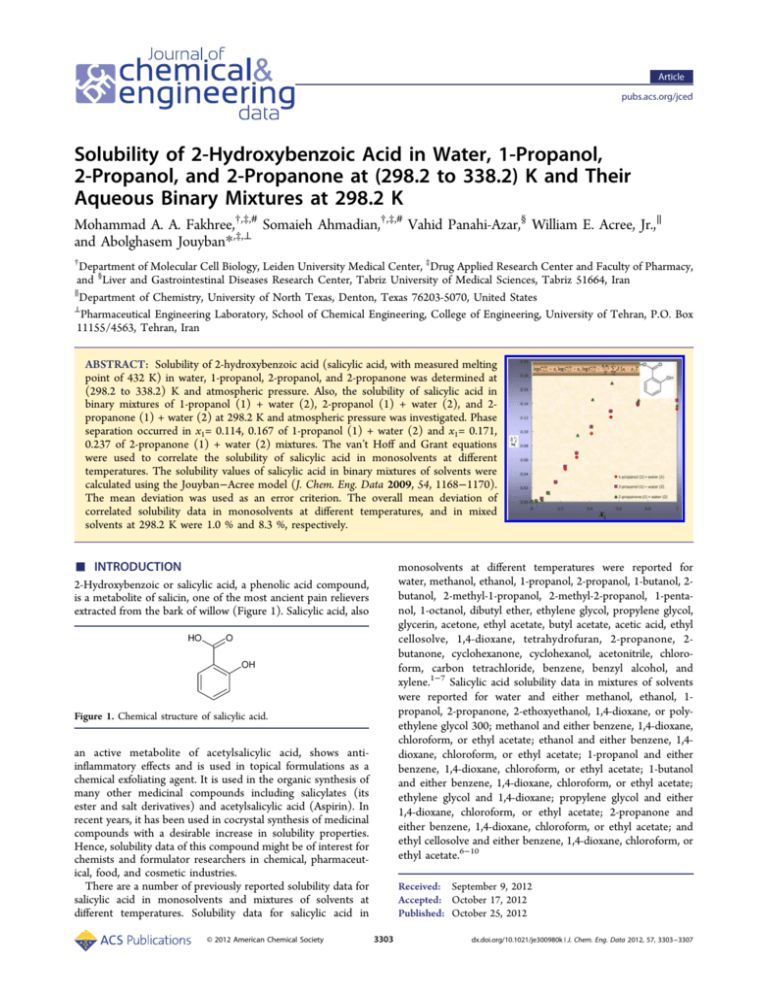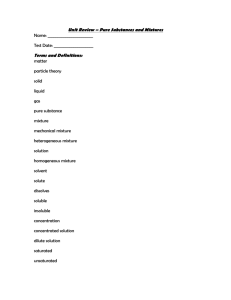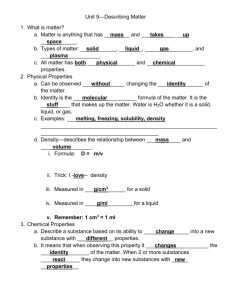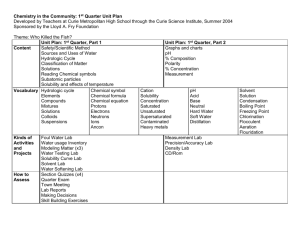Solubility of 2-Hydroxybenzoic Acid in Water, 1
advertisement

Article pubs.acs.org/jced Solubility of 2‑Hydroxybenzoic Acid in Water, 1‑Propanol, 2‑Propanol, and 2‑Propanone at (298.2 to 338.2) K and Their Aqueous Binary Mixtures at 298.2 K Mohammad A. A. Fakhree,†,‡,# Somaieh Ahmadian,†,‡,# Vahid Panahi-Azar,§ William E. Acree, Jr.,∥ and Abolghasem Jouyban*,‡,⊥ † Department of Molecular Cell Biology, Leiden University Medical Center, ‡Drug Applied Research Center and Faculty of Pharmacy, and §Liver and Gastrointestinal Diseases Research Center, Tabriz University of Medical Sciences, Tabriz 51664, Iran ∥ Department of Chemistry, University of North Texas, Denton, Texas 76203-5070, United States ⊥ Pharmaceutical Engineering Laboratory, School of Chemical Engineering, College of Engineering, University of Tehran, P.O. Box 11155/4563, Tehran, Iran ABSTRACT: Solubility of 2-hydroxybenzoic acid (salicylic acid, with measured melting point of 432 K) in water, 1-propanol, 2-propanol, and 2-propanone was determined at (298.2 to 338.2) K and atmospheric pressure. Also, the solubility of salicylic acid in binary mixtures of 1-propanol (1) + water (2), 2-propanol (1) + water (2), and 2propanone (1) + water (2) at 298.2 K and atmospheric pressure was investigated. Phase separation occurred in x1= 0.114, 0.167 of 1-propanol (1) + water (2) and x1= 0.171, 0.237 of 2-propanone (1) + water (2) mixtures. The van’t Hoff and Grant equations were used to correlate the solubility of salicylic acid in monosolvents at different temperatures. The solubility values of salicylic acid in binary mixtures of solvents were calculated using the Jouyban−Acree model (J. Chem. Eng. Data 2009, 54, 1168−1170). The mean deviation was used as an error criterion. The overall mean deviation of correlated solubility data in monosolvents at different temperatures, and in mixed solvents at 298.2 K were 1.0 % and 8.3 %, respectively. ■ INTRODUCTION 2-Hydroxybenzoic or salicylic acid, a phenolic acid compound, is a metabolite of salicin, one of the most ancient pain relievers extracted from the bark of willow (Figure 1). Salicylic acid, also monosolvents at different temperatures were reported for water, methanol, ethanol, 1-propanol, 2-propanol, 1-butanol, 2butanol, 2-methyl-1-propanol, 2-methyl-2-propanol, 1-pentanol, 1-octanol, dibutyl ether, ethylene glycol, propylene glycol, glycerin, acetone, ethyl acetate, butyl acetate, acetic acid, ethyl cellosolve, 1,4-dioxane, tetrahydrofuran, 2-propanone, 2butanone, cyclohexanone, cyclohexanol, acetonitrile, chloroform, carbon tetrachloride, benzene, benzyl alcohol, and xylene.1−7 Salicylic acid solubility data in mixtures of solvents were reported for water and either methanol, ethanol, 1propanol, 2-propanone, 2-ethoxyethanol, 1,4-dioxane, or polyethylene glycol 300; methanol and either benzene, 1,4-dioxane, chloroform, or ethyl acetate; ethanol and either benzene, 1,4dioxane, chloroform, or ethyl acetate; 1-propanol and either benzene, 1,4-dioxane, chloroform, or ethyl acetate; 1-butanol and either benzene, 1,4-dioxane, chloroform, or ethyl acetate; ethylene glycol and 1,4-dioxane; propylene glycol and either 1,4-dioxane, chloroform, or ethyl acetate; 2-propanone and either benzene, 1,4-dioxane, chloroform, or ethyl acetate; and ethyl cellosolve and either benzene, 1,4-dioxane, chloroform, or ethyl acetate.6−10 Figure 1. Chemical structure of salicylic acid. an active metabolite of acetylsalicylic acid, shows antiinflammatory effects and is used in topical formulations as a chemical exfoliating agent. It is used in the organic synthesis of many other medicinal compounds including salicylates (its ester and salt derivatives) and acetylsalicylic acid (Aspirin). In recent years, it has been used in cocrystal synthesis of medicinal compounds with a desirable increase in solubility properties. Hence, solubility data of this compound might be of interest for chemists and formulator researchers in chemical, pharmaceutical, food, and cosmetic industries. There are a number of previously reported solubility data for salicylic acid in monosolvents and mixtures of solvents at different temperatures. Solubility data for salicylic acid in © 2012 American Chemical Society Received: September 9, 2012 Accepted: October 17, 2012 Published: October 25, 2012 3303 dx.doi.org/10.1021/je300980k | J. Chem. Eng. Data 2012, 57, 3303−3307 Journal of Chemical & Engineering Data Article diluted solutions were computed using a UV absorbance calibration graph with the molar absorptivities of salicylic acid ranging from ε = 4425.7 (L·mol−1·cm−1) to ε = 4279.7 (L·mol−1·cm−1) and concentrations ranging from (2.90·10−4 to 1.45·10−4) mol·L−1. Each experimental data point is the mean of at least three independent measurements with the measured mol·L−1 solubilities reproducible to within the mean relative standard deviations (RSDs) of 2.6 % and 1.9 % in monosolvents at different temperatures and mixed solvents at 298.2 K, respectively. Calculated standard deviations of the solubilities ranged from σn‑1= 2.6·10−4 to σn‑1 = 1.1·10−1 mol·L−1 and σn‑1 = 2.6·10−5 to σn‑1 = 7.9·10−2 mol·L−1 for monosolvents at different temperatures and aqueous mixtures of solvents at 298.2 K, respectively, with relative standard uncertainty near to 1 % or ur(x) = 0.01. Densities of the saturated solutions were obtained using a 5 mL pycnometer with the method uncertainty of 0.001 g·cm−3 as triplicate determinations. Computational Methods. Among reported models for solubility correlation or prediction in mixture of solvents, the Jouyban-Acree model, is able to correlate solubility with acceptable error. The basic Jouyban-Acree model is12−14 The aims of the present study are to determine the solubility of salicylic acid in water, 1-propanol, 2-propanol, and 2propanone at (298.2 to 338.2) K and in 1-propanol (1) + water (2), 2-propanol (1) + water (2), and 2-propanone (1) + water (2) mixtures at 298.2 K and atmospheric pressure. In addition, solubility correlation of salicylic acid in the monosolvents at different temperatures and their mixtures is investigated. ■ EXPERIMENTAL METHOD Materials. 2-Hydroxybenzoic acid or salicylic acid with the Chemical Abstract Service No. of 69-72-7 (purity >0.99 in mass fraction) was purchased from Merck (Germany). [Note: Salicylic acid is an irritant compound to the upper respiratory tract and acts as an abrasive on skin.] The measured melting point temperature of the compound was 432 K. 1-Propanol (0.999 in mass fraction), 2-propanol (0.999 in mass fraction), and 2-propanone (0.995 in mass fraction) were purchased from Scharlau Chemie (Spain). Ethanol (0.935 in mass fraction) was purchased from Jahan Alcohol Teb (Arak, Iran) and was used to dilute the samples before spectrophotometric analysis. Doubled-distilled water with a conductance of <1.5 μS·cm−1 was used. A summary of used materials are presented in Table 1. Sat Sat Sat log Cm,T = x1log C1,T + x 2 log C2,T + Table 1. Purity of Chemicals Used in This Study along with Their Applications material purity (mass fraction) salicylic acid 1-propanol >0.99 0.999 2-propanol 0.999 2-propanone 0.995 water double distilled 0.935 ethanol application Merck, Germany Scharlau Chemie, Spain Scharlau Chemie, Spain Scharlau Chemie, Spain lab made solute preparation of solvent mixtures preparation of solvent mixtures preparation of solvent mixtures preparation of solvent mixtures diluting samples for UV analysis Jahan Teb, Iran 2 ∑ Ji (x1 − x2)2 i=0 (1) CSat m,T, source x1x 2 T CSat 1,T, CSat 2,T −1 where and are mol·L solubility of the solute in mixture of solvents, solvent 1, and solvent 2, respectively; x1 and x2 are the mole fractions of solvents 1 and 2 in the absence Sat of the solute (if log CSat 1,T > log C2,T); and Ji coefficients are the solvent−solvent and solute−solvent interaction terms. For solubility correlation of a solute in a solvent at different temperatures, van’t Hoff equation is applicable15 a log C TSat = +b (2) T where CTSat is the saturated molar solubility at different temperatures and a and b are the model constants calculated using a least-squares method. However, in the case of nonlinear pattern of solubility at different temperatures, Grant et al. proposed the following equation for better correlation15 a log C TSat = + b log T + c (3) T Apparatus and Procedures. The solubility of salicylic acid in 1-propanol, 2-propanol, 2-propanone, and water was measured at (298.2, 308.2, 318.2, 328.2, and 338.2) K and atmospheric pressure. An excess amount of the solid was placed into the monosolvents and incubated in ovens at (298.2 ± 0.2, 308.2 ± 0.2, 318.2 ± 0.4, 328.2 ± 0.4, and 338.2 ± 0.6) K (Behdad, Tehran, Iran), for 3 days. The samples were shaken manually three times a day to ensure the equilibration was reached. Results of a previous paper indicated the efficacy of this method.11 In the case of binary solvent mixtures, appropriate masses of the solvents were mixed together. The solvents’ mole fractions were computed using the densities of the pure solvents. The solvent composition could be calculated to 0.001 mol fraction. The solubility of salicylic acid was determined by equilibrating an excess amount of the solid with the binary solvent mixtures using a shaker (Behdad, Tehran, Iran) which were incubated in a temperature controlling system at 298.2 ± 0.2 K (Nabziran, Tabriz, Iran). The solutions were filtered using hydrophilic Durapore filters (0.45 μm, Millipore, Ireland). All of the solutions were diluted by ethanol prior to further analyses. Spectrophotometric analysis was performed at 304 nm for the samples with a UV−vis spectrophotometer (Beckman DU-650, Fullerton, U.S.A.). Concentrations of the where a, b, and c are model constants. Comparing correlated solubilities with the corresponding experimental values, the following equations were used to calculate the mean deviation (MD) and individual deviation (ID) MD = 100 N ∑ ID = 100∑ |CCor − Cexpt| Cexpt (4) |CCor − Cexpt| Cexpt (5) in which N is the number of data points. ■ RESULTS AND DISCUSSION Table 2 lists the densities of the saturated solutions, experimental and correlated, solubility values of salicylic acid in water, 1-propanol, 2-propanol, and 2-propanone solutions at different temperatures. As expected, the solubility of salicylic 3304 dx.doi.org/10.1021/je300980k | J. Chem. Eng. Data 2012, 57, 3303−3307 Journal of Chemical & Engineering Data Article Table 2. Saturated Solution Densities, Experimental and Correlated Solubilities of Salicylic Acid in Water, 1-Propanol, 2Propanol, and 2-Propanone at (298.2 to 338.2) K at Atmospheric Pressure, Relative Standard Deviation (RSD)a, and Mole Fraction Solubility (x2) of Salicylic Acid −1 CSat T /mol·L x2 cor. T/K ρ/g·cm−3 expt. 298.2 308.2 318.2 328.2 338.2 0.984 0.983 0.981 0.979 0.977 1.61·10−2 1.93·10−2 2.75·10−2 3.78·10−2 5.09·10−2 298.2 308.2 318.2 328.2 338.2 0.886 0.890 0.898 0.904 0.917 1.66 1.86 2.01 2.19 2.38 298.2 308.2 318.2 328.2 338.2 0.883 0.889 0.899 0.907 0.922 1.78 1.97 2.11 2.35 2.57 298.2 308.2 318.2 328.2 338.2 0.909 0.912 0.920 0.927 ND* 1.80 1.83 2.03 2.46 ND* RSD % Water 1.6 4.6 4.4 0.9 2.0 1-Propanol 0.6 1.0 2.5 5.2 4.5 2-Propanol 1.6 3.1 2.5 4.2 2.6 2-Propanone 0.2 2.6 2.5 3.8 eq 2 eq 3 expt. 1.51·10−2 2.08·10−2 2.83·10−2 3.76·10−2 4.93·10−2 1.58·10−2 2.03·10−2 2.70·10−2 3.69·10−2 5.17·10−2 0.295·10−3 0.355·10−3 0.507·10−3 0.699·10−3 0.944·10−3 1.67 1.84 2.02 2.19 2.38 1.67 1.84 2.02 2.20 2.37 0.132 0.150 0.163 0.179 0.195 1.78 1.96 2.15 2.35 2.55 1.79 1.95 2.14 2.34 2.57 0.144 0.161 0.173 0.195 0.214 1.72 1.92 2.13 2.34 1.80 1.83 2.04 2.46 0.137 0.139 0.156 0.196 ND* a The relative standard uncertainty for the solubilities is near 1 % or ur(x) = 0.01, with uncertainty of 0.001 g·cm−3 for density, the uncertainty for temperature is 0.2 K, and the measurements were made at atmospheric pressure. *ND: Not able to be determined because of solvent evaporation. acid increases with increasing temperature for the four monosolvents investigated in this work. Densities of the aqueous solutions gradually decrease with increase in temperature which could be explained by volume expansion at higher temperatures. Comparisons between previously reported mol·L−1 solubility values for salicylic acid at 298.2 K in water 0.00825,4 0.018,5 0.012,8 and 0.01599 with the result of this work 0.0161 and mole fraction solubility values 0.1636,1 0.1789,1 and 0.18171 respectively for 1-propanol, 2-propanol, and 2-propanone with the results of this work 0.132, 0.144, and 0.137 respectively for 1-propanol, 2-propanol, and 2-propanone reveal that there is almost agreement between them. As it is reported and discussed by Matsuda et al., there are considerable differences between reported solubility values for salicylic acid from different groups.6 One possible reason as argued by Nordstrom and Rasmuson2 and Matsuda et al.6 could be the water content of organic solvents. However, this cannot explain the observed variances for solubility values in water. Another possible reason might be the chemical reactivity of the salicylic acid. For example, salicylic acid is converted to methyl salicylate in aqueous methanolic mixtures. Although this esterification might happen in small quantities, however, the smell of the methyl salicylate was recognizable in those experiments, indicating esterification had happened in methanolic aqueous solutions. Because of this fact, we did not measure these data. Following equations are proposed for solubility correlation at different temperatures for 1-propanol log C TSat = − 384.958 + 1.514, T R2 = 0.997, (6) MD = 0.5 % and for 2-propanol log C TSat = − 396.006 + 1.578, T R2 = 0.994, (7) MD = 0.8 % for showing the solubility pattern in water log C TSat = 5338.017 + 48.157 log T − 138.867, T R2 = 0.995, MD = 2.6 % (8) and for 2-propanone log C TSat = 12249.404 + 93.438 log T − 272.035, T R2 = 0.999, MD = 0.1 % (9) for showing nonlinear patterns. As previously reported, van’t Hoff (eqs 6 and 7) and Grant equations (eqs 8 and 9) are suitable for linear and nonlinear solubility pattern correlation at different temperatures, respectively. The overall MD of 1.0 % is obtained for solubility correlation in monosolvents at various temperatures. Table 3 gives the densities of the saturated solutions, the experimental solubility of salicylic acid in binary solvent 3305 dx.doi.org/10.1021/je300980k | J. Chem. Eng. Data 2012, 57, 3303−3307 Journal of Chemical & Engineering Data Article There was phase separation in x1 = 0.114, 0.167 of 1propanol (1) + water (2) and x1 = 0.171, 0.237 of 2-propanone (1) + water (2) mixtures. To the best of our knowledge, this is the first report on phase separation of 1-propanol (1) + water (2) and 2-propanone (1) + water (2) mixtures in the presence of an organic solid solute. Paruta et al. studied the solubility of salicylic acid in aqueous 2-propanone and 1-propanol mixtures, without phase separation observation. However, they only studied three limited fractions for a narrow part of possible solvent mixtures. Also, phase separation in aqueous 1,4-dioxane mixtures was not reported by Matsuda and co-workers,6 whereas it was reported by other groups. This phenomenon has been reported previously for salicylic acid and other similar compounds including ibuprofen, benzocaine, and either ethyl, propyl, or butyl parabens in aqueous mixtures of 1,4-dioxane and ethanol.7,16−18 It is temperature dependent and occurs at higher temperatures. Lower melting point temperatures and lower enthalpies of fusion, and hydrophobic effect were suggested as possible factors responsible for the observed phase separation.7,16 Another possible explanation for this phase separation, might be a mechanism similar to salting out, as it has been reported for aqueous mixtures of 1-propanol, 2propanol, 2-propanone, acetonitrile, 1,4-dioxane, and tetrahydrofuran in presence of alkali salts.19,20 The experimental data reported in this study extends the available solubility databases13,21 of drug/drug like molecules in monosolvent systems at different temperatures and binary solvent mixtures. The Jouyban−Acree model could be trained at one temperature (usually 298.2 K) and then used to predict the solubility of salicylic acid in the mixed solvents at other temperatures of interest employing the experimental data in monosolvents at these temperatures as shown in previous works.22,23 The generated data in monosolvents at various temperatures of Table 2 and the model constants of Table 3 could be combined to provide a predictive computational method for the solubility of salicylic acid in the related aqueous binary mixtures for solubilization/desolubilization of the solute using solvent composition and/or temperature changes. This prediction method facilitates the process design and reduces the time required for crystallization and/or cocrystal investigations in the pharmaceutical industry. Table 3. Solute Saturated Solution Densities, Experimental and Calculated Molar Solubilities, Numerical Values of the Jouyban−Acree Model Constants (J Terms), the Related Individual Deviations (ID), and Mole Fraction Solubility (x3) of Salicylic Acid (3) in Binary Mixtures of 1-Propanol (1) + Water (2), 2-Propanol (1) + Water (2), and 2Propanone (1) + Water (2) at 298.2 K and Relative Standard Deviation (RSD)a −1 CSat m,T/mol·L x1 1.000 0.730 0.545 0.411 0.310 0.231 0.167 0.114 0.070 0.032 0.000 1.000 0.730 0.545 0.411 0.310 0.231 0.167 0.114 0.070 0.032 0.000 1.000 0.736 0.554 0.420 0.317 0.237 0.171 0.117 0.072 0.033 0.000 ρ/ g·cm−3 expt. RSD % cor. ID 1-Propanol (1) + Water (2) J0 = 1159.9, J1 = −1184.1, J2 = 1599.0, R2 = 0.997 0.886 1.66 0.6 1.66 0.0 0.912 1.87 1.0 2.03 8.4 0.921 1.79 2.3 1.55 13.3 0.928 1.61 4.4 1.54 3.9 0.931 1.20 0.5 1.42 17.9 0.937 1.00 0.1 1.04 3.9 PS* PS* PS* PS* 0.958 1.43·10−1 1.3 1.20·10−1 16.0 −2 0.970 4.77·10 0.7 4.52·10−2 5.1 0.984 1.61·10−2 1.6 1.61·10−2 0.0 2-Propanol (1) + Water (2) J0 = 1150.7, J1 = −1273.9, J2 = 1762.1, R2 = 0.997 0.883 1.79 1.6 1.78 0.0 0.904 1.88 2.4 2.08 11.1 0.917 1.88 1.6 1.57 16.8 0.924 1.72 1.6 1.62 5.7 0.926 1.29 2.2 1.57 22.1 0.930 1.06 3.0 1.19 12.0 0.936 6.98·10−1 5.6 6.97·10−1 0.1 −1 0.944 3.72·10 3.7 3.29·10−1 11.5 0.956 1.60·10−1 4.5 1.32·10−1 17.5 0.969 4.59·10−2 0.8 4.78·10−2 4.1 0.984 1.61·10−2 1.6 1.61·10−2 0.0 2-Propanone (1) + Water (2) J0 = 1369.7, J1 = −1344.5, J2 = 955.3, R2 = 0.997 0.909 1.80 0.2 1.80 0.0 0.950 2.08 0.4 2.15 3.7 0.968 2.52 0.9 2.32 7.8 0.975 2.39 3.3 2.41 0.8 0.974 1.80 3.6 2.00 11.0 PS* PS* PS* PS* 0.957 3.83·10−1 1.1 2.98·10−1 22.0 0.961 1.00·10−1 4.0 1.19·10−1 18.7 0.971 4.10·10−2 0.1 4.45·10−2 8.6 0.984 1.61·10−2 1.6 1.61·10−2 0.0 x3 0.132 0.138 0.121 0.975·10−1 0.637·10−1 0.467·10−1 0.401·10−2 0.110·10−2 0.295·10−3 0.144 0.140 0.129 0.106 0.692·10−1 0.504·10−1 0.282·10−1 0.126·10−1 0.452·10−2 0.106·10−2 0.295·10−3 0.137 0.145 0.169 0.146 0.948·10−1 ■ AUTHOR INFORMATION Corresponding Author *E-mail: ajouyban@hotmail.com; jouyban@ut.ac.ir. Fax: +98 411 3363231. 0.125·10−1 0.275·10−2 0.934·10−3 0.295·10−3 Author Contributions # These authors contributed equally to this work. Notes The authors declare no competing financial interest. ■ a The relative standard uncertainty for the solubilities is near 1 % or ur(x) = 0.01, with uncertainty of 0.001 g·cm−3 for density, the uncertainty for temperature is 0.2 K, and the measurements were made at atmospheric pressure. *PS: phase separation occurred in the presence of solute. REFERENCES (1) De Fina, K. M.; Sharp, T. L.; Roy, L. E.; Acree, W. E., Jr. Solubility of 2-hydroxybenzoic acid in select organic solvents at 298.15 K. J. Chem. Eng. Data 1999, 44, 1262−1264. (2) Nordstrom, F. L.; Rasmuson, A. C. Solubility and Melting Properties of Salicylic Acid. J. Chem. Eng. Data 2006, 51, 1668−1671. (3) Shalmashi, A.; Eliassi, A. Solubility of Salicylic Acid in Water, Ethanol, Carbon Tetrachloride, Ethyl Acetate, and Xylene. J. Chem. Eng. Data 2008, 53, 199−200. (4) Mota, F. L.; Queimada, A. J.; Pinho, S. P.; Macedo, E. A. Aqueous Solubility of Some Natural Phenolic Compounds. Ind. Eng. Chem. Res. 2008, 47, 5182−5189. mixtures, correlated J terms and solubility values using the Jouyban−Acree model, along with individual deviation (ID) values for each data point. The overall MD value in correlating solubility values in binary solvent mixtures using the Jouyban− Acree model is 8.3 %. 3306 dx.doi.org/10.1021/je300980k | J. Chem. Eng. Data 2012, 57, 3303−3307 Journal of Chemical & Engineering Data Article (5) Good, D. J.; Rodrıguez-Hornedo, N. Solubility Advantage of Pharmaceutical Cocrystals. Cryst. Growth Des. 2009, 9, 2252−2264. (6) Matsuda, H.; Kaburagi, K.; Matsumoto, Sh.; Kurihara, K.; Tochigi, K.; Tomono, K. Solubilities of Salicylic Acid in Pure Solvents and Binary Mixtures Containing Cosolvent. J. Chem. Eng. Data 2009, 54, 480−484. (7) Paruta, A. N.; Sciarrone, B. J.; Lordi, N. G. Solubility of Salicylic Acid as a Function of Dielectric Constant. J. Pharm. Sci. 1964, 53, 1349−1353. (8) Pena, M. A.; Bustamante, P.; Escalera, B.; Reıllo, A.; BosqueSendra, J. M. Solubility and phase separation of benzocaine and salicylic acid in 1,4-dioxane−water mixtures at several temperatures. J. Pharm. Biomed. Anal. 2004, 36, 571−578. (9) Wang, X.; Ponder, C. S.; Kirwan, D. J. Low Molecular Weight Poly(ethylene glycol) as an Environmentally Benign Solvent for Pharmaceutical Crystallization and Precipitation. Crys. Growth Des. 2005, 5, 85−92. (10) Pena, M. A.; Escalera, B.; Reıllo, A.; Sanchez, A. B.; Bustamante, P. Thermodynamics of Cosolvent Action: Phenacetin, Salicylic Acid and Probenecid. J. Pharm. Sci. 2009, 98, 1129−1135. (11) Ahmadian, S.; Panahi-Azar, V.; Fakhree, M. A. A.; Acree, W. E., Jr.; Jouyban, A. Solubility of Phenothiazine in Water, Ethanol, and Propylene Glycol at (298.2 to 338.2) K and Their Binary and Ternary Mixtures at 298.2 K. J. Chem. Eng. Data 2011, 56, 4352−4355. (12) Jouyban, A. Review of the cosolvency models for predicting solubility of drugs in water-cosolvent mixtures. J. Pharm. Pharm. Sci. 2008, 11, 32−58. (13) Jouyban, A. Handbook of Solubility Data for Pharmaceuticals; CRC Press: Boca Raton, FL, 2009. (14) Jouyban, A., Fakhree, M. A. A. Experimental and Computational Methods Pertaining to Drug Solubility. In Toxicity and Drug Testing; Acree, W. E., Jr., Ed.; InTech Publisher: New York, 2012. (15) Grant, D. J. W.; Mehdizadeh, M.; Chow, A. H. L.; Fairbrother, J. E. Non-Linear van’t Hoff Solubility-Temperature Plots and Their Pharmaceutical Interpretation. Int. J. Pharm. 1984, 18, 25−38. (16) Manrique, J.; Martinez, F. Solubility of Ibuprofen in Some Ethanol + Water Cosolvent Mixtures at Several Temperatures. Lat. Am. J. Pharm. 2007, 26, 344−354. (17) Paruta, A. N. Solubility of the Parabens in Ethanol-Water Mixtures. J. Pharm. Sci. 1969, 58, 364−366. (18) Paruta, A. N. Solubility of the Parabens in Dioxane-Water Mixtures. J. Pharm. Sci. 1969, 58, 204−206. (19) Tabata, M.; Kumamoto, M.; Nishimoto, J. Chemical Properties of Water-Miscible Solvents Separated Salting-out and Their Application to Solvent Extraction. Anal. Sci. 1994, 10, 383−388. (20) Yoko, H.; Katsumi, Y.; Kenji, M.; Masakatsu, M. The Phase Separation of the Water-1-Propanol Mixtures Induced by the Addition of Various Alkali Chlorides. Yoeki Kagaku Shinpojiumu Koen Yoshishu 1998, 21, 144−145. (21) Yalkowsky, S. H.; He, Y.; Jain, P. Handbook of Aqueous Solubility Data, 2nd ed.; CRC Press: Boca Raton, FL, 2010. (22) Jouyban, A.; Shokri, J.; Barzegar-Jalali, M.; Hassanzadeh, D.; Acree, W. E., Jr.; Ghafourian, T.; Nokhodchi, A. Solubility of Chlordiazepoxide, Diazepam, and Lorazepam in Ethanol + Water Mixtures at 303.2 K. J. Chem. Eng. Data 2009, 54, 2142−2145. (23) Jouyban, A.; Acree, W. E., Jr. Comments on “Solubility of Ethyl Maltol in Aqueous Ethanol Mixtures. J. Chem. Eng. Data 2009, 54, 1168−1170. 3307 dx.doi.org/10.1021/je300980k | J. Chem. Eng. Data 2012, 57, 3303−3307






